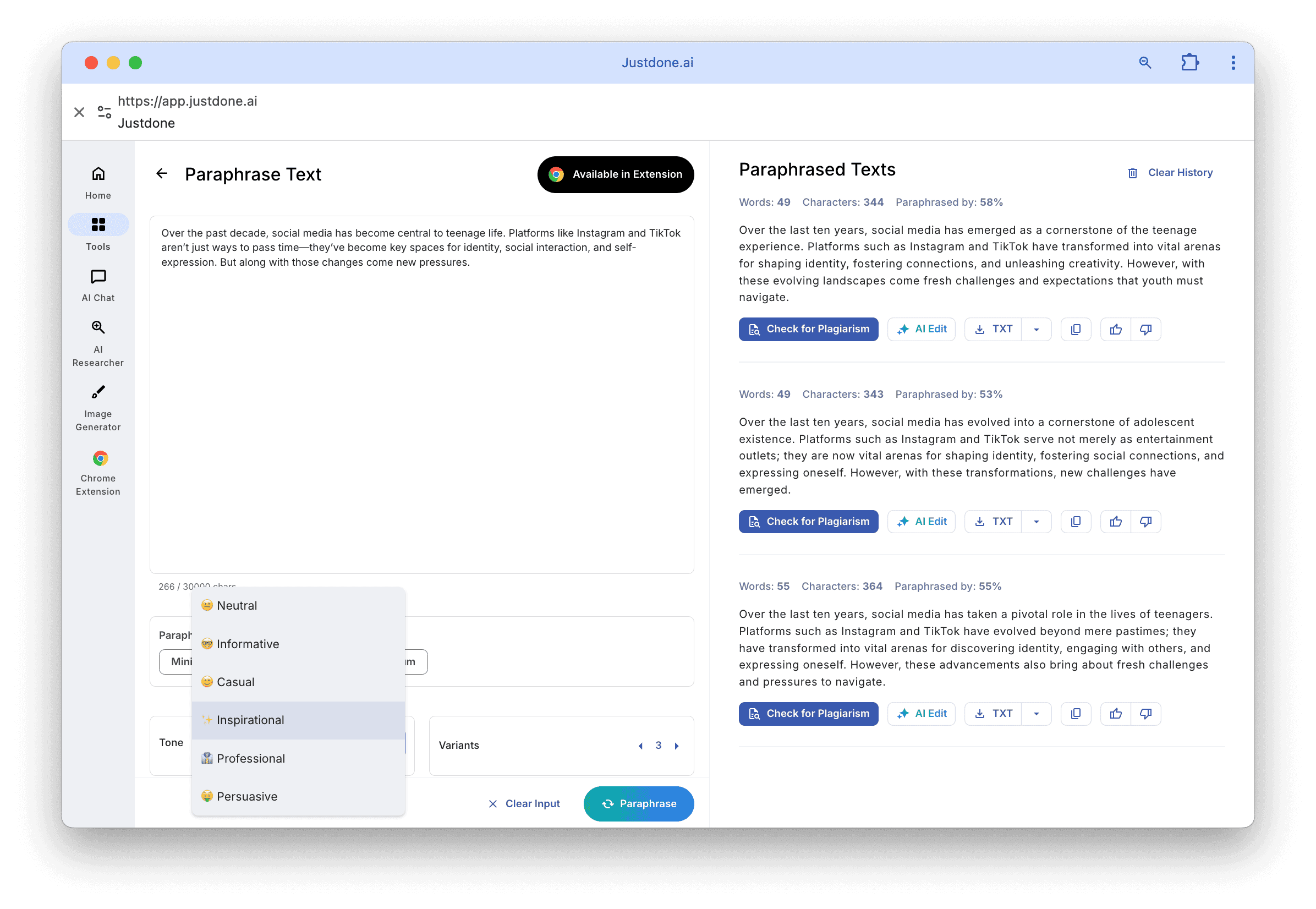Let’s be honest. Writing dialogue that sounds natural, moves your story forward, and doesn’t make readers cringe? It’s harder than it looks.
When I started writing fiction back in college, my characters either sounded like stiff robots or overly dramatic soap opera extras. Learning how to write a dialogue that felt real took time. The good news? You don’t have to figure it out on your own.
In this post, I’ll break down everything I’ve learned from the types of dialogue that drive a scene to the structure, punctuation, and common mistakes to avoid. I’ll also show you a few moments where JustDone’s writing tool can save the day when your dialogue just isn’t working.
So let’s dive in.
How to Write Dialogue That Feels Real
Let’s talk about dialogue. It’s one of the most important parts of storytelling, whether you’re writing fiction, a screenplay, or a short story for class. But a lot of writers get stuck because they treat dialogue like filler, just lines for characters to say so something’s happening on the page.
The truth is, dialogue is where your characters come alive. It’s how we get to know them, understand their motivations, and watch relationships shift. Great dialogue moves the plot forward, creates conflict, and makes your reader feel like they’re not just reading your story but listening to it happen.
Think of your favorite book or movie. Chances are, the scenes you remember most are about what people said, and how they said it.
How to Write Different Types of Dialogue in Your Story
Before you jump into writing dialogue, it helps to know what kinds of conversation you’re actually trying to write. Not every line is the same, and knowing the difference will save you a lot of editing later.
There’s direct dialogue, which is exactly what it sounds like. Character A says something, Character B responds. It’s the stuff inside quotation marks. Like:
“I can’t believe you did that,” she said.
Then there’s indirect dialogue. This is when you summarize a conversation without quoting it directly. For example:
She told him she couldn’t believe what he did.
Sometimes you’ll need internal dialogue - that’s when the character talks to themselves, either in their head or in narration. It’s especially useful in first-person stories or third-person limited perspectives. Something like:
“I should’ve seen this coming, he thought.”
And don’t forget about monologues. These are longer speeches from one character. You’ll see this a lot in plays, but monologues pop up in fiction too, usually in big emotional moments.
Understanding which type of dialogue you’re writing helps you stay intentional. If you’re not sure how to shift between these styles smoothly, JustDone’s AI Humanizer can help adjust your tone. It’s great for turning stiff narration into believable conversation or softening dialogue that feels too mechanical.

How to Structure Dialogue So It Feels Natural
Dialogue isn’t just about what’s said; I’d say it’s about how it’s presented. If the structure is messy, the reader will trip over your lines instead of getting absorbed in the scene. That’s why format matters just as much as content.
When you write dialogue, keep it simple. Quotation marks for spoken lines. A dialogue tag like “she said” or “he asked” to clarify who’s talking. And, if it fits, a small action or emotion to give the scene texture.
For example:
“I’m not going,” she whispered, her fingers tightening around the suitcase.
Notice how that line shows us how she feels. The tension is in her hands, not just her words.
Remember to start a new paragraph every time a new character speaks. Keep your dialogue tags simple. You don’t need to say "he exclaimed" or "she opined" when "he said" works just fine. And don’t forget about beats (those little descriptions of gestures or facial expressions) that make your characters feel real.
How to Punctuate Dialogue the Right Way
Frankly speaking, punctuation is where a lot of writers get tripped up with dialogue. But once you get the hang of it, it’s second nature.
Use double quotation marks for direct speech. Put commas inside the quotation marks when you’re adding a dialogue tag, unless the line ends with a question mark or exclamation point. If you’ve got a quote inside a quote, switch to single quotation marks for the inner one. Like this:
“He literally said, ‘I quit,’ and walked out.”
These little rules keep your dialogue clear and easy to follow.
How to Start a Conversation or Monologue Without Making It Awkward
If you’ve ever read dialogue that feels stiff, chances are it started the wrong way. Beginners often fall into the trap of opening with an exposition dump or weirdly formal greetings.
Dialogue works better when you start in media res, right in the middle of the action or tension. Let the reader figure out the context naturally, through the way the characters talk to each other.
Here’s an example of what not to do:
“Hello, John. How are you this fine afternoon in April, after such a long time apart?”
Nobody talks like that. Here’s a better way:
“You’re late.”
John didn’t even look up. “Traffic.”
“You always say that.”
See how much more natural that feels? You’re starting with tension, not small talk. The conversation reveals the relationship without a long setup.
Again. If you’re writing your dialogues with the help of AI assistants, run a draft through JustDone’s AI Humanizer. It helps catch overly formal openings and turns them into lines that sound like real people talking, not robots reading a script.
What to Avoid When Writing Dialogue
When I first started writing, I made every rookie mistake in dialogue you can imagine. So let me save you some time.
Don’t overuse names. In real life, people don’t say each other’s names in every sentence. It’s weird on the page too.
Watch out for info dumps. Dialogue isn’t the place to shove in backstory all at once. Let it come out naturally, through hints and implications.
Don’t make your characters sound like they’re reading essays aloud. Real people interrupt each other, change the subject, trail off mid-sentence. That’s part of what makes dialogue feel human.
And finally, stick with simple dialogue tags most of the time. You don’t need to say "he exclaimed" or "she retorted" in every line. "Said" works. It’s invisible in the best way.

Examples of Dialogue That Actually Works
Let’s look at a few quick lines to show how dialogue can do more than just fill space. Here’s one that builds conflict:
“You’re going without me?”
“You said you didn’t care.”
“That’s not what I meant.”
And here’s one that’s heavy on subtext:
“I saw your car last night.”
“Oh?”
“Yeah. Parked outside her place.”
Notice how much is happening between the lines? That’s the magic of good dialogue. It’s not about spelling everything out; it’s about letting the reader feel the tension.
Final Thoughts: How to Write Dialogue That Sticks in Your Reader’s Mind
Writing great dialogue takes practice, but the payoff is worth it. Strong dialogue gives your characters life. It drives your plot. It pulls your reader into the scene and makes them forget they’re reading at all.
So the next time you sit down to write and wonder how to make your dialogue work, think about rhythm and subtext. Listen to how people really talk. And when you get stuck, remember you’ve got tools like JustDone’s AI Humanizer to help you smooth out the rough spots without losing your voice.
Dialogue is where characters breathe. Make sure they sound like they’re alive.